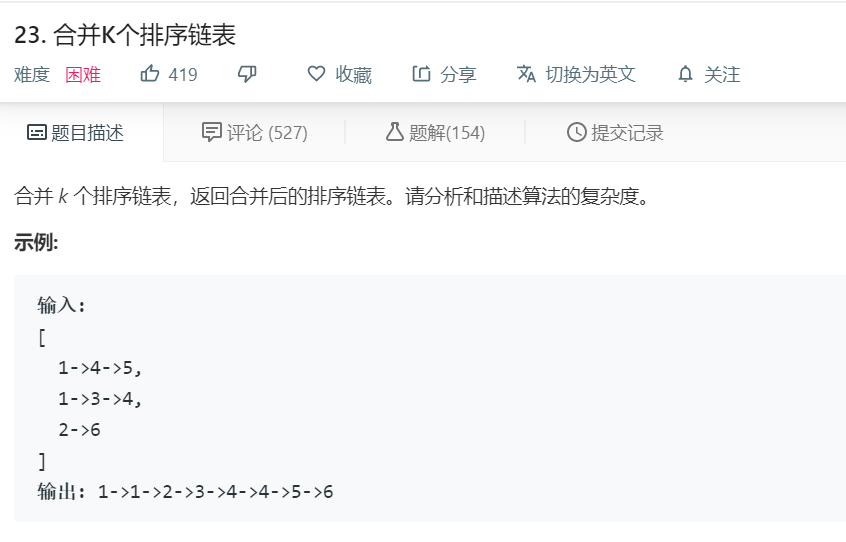标签:归并排序 start 创建 tno 关注 alt 针对 img queue

这道题属于双链表合并的进阶。理解这道题首先需要了解有序双链表合并的解法。
已知链表有序,使用两个指针指向两个链表,逐一比较大小移动指针。代码很简单如下所示。
public ListNode mergeTwoLists(ListNode l1, ListNode l2) {
ListNode dummy = new ListNode(Integer.MIN_VALUE);
ListNode cur = dummy;
while (l1 != null && l2 != null) {
if (l1.val < l2.val) {
cur.next = l1;
l1 = l1.next;
} else {
cur.next = l2;
l2 = l2.next;
}
cur = cur.next;
}
cur.next = l1 == null ? l2 : l1;
return dummy.next;
}两个有序链表合并,我们用到了两个指针。那么N个链表,显然无法保存N个指针去遍历和移动。所以需要换种思路,可以对链表逐一进行两两合并。但是这样会导致链表的重复遍历。此时可以用到归并排序中的思路:分治法。将链表对半拆分到单链表,再进行两两合并,这样就不会有重复遍历,详情见方法三。
同时,如果题目不要求空间复杂度,可以使用数组或集合来快速实现整体的排序,容易理解,见方法一。
扩展思路,双链表合并,每次需要比较计算两个指针大小。那么k个链表每次需要计算K个指针对应的节点大小。此时可以想到使用优先级队列,具体见方法二。
不要求空间复杂度情况,可以借助数组集合,遍历所有的链表上的节点,放入集合中,进行排序。再从集合中将其取出,构造新链表
/**
* 如果不限制空间复杂度,可以放到数组中排序,再拿出
* 时间复杂度O(NlogN) = 遍历所有值 O(N) + 稳定排序算法O(NlongN) + 遍历创建新链表O(N)
*/
public ListNode mergeKLists1(ListNode[] lists) {
List<ListNode> allList = new ArrayList<>();
for (ListNode node : lists) {
while (node != null) {
allList.add(node);
node = node.next;
}
}
allList.sort(new Comparator<ListNode>() {
@Override
public int compare(ListNode o1, ListNode o2) {
return o1.val - o2.val;
}
});
ListNode dummy = new ListNode(0);
ListNode cur = dummy;
for (ListNode node : allList) {
cur.next = node;
cur = cur.next;
}
cur.next = null;
return dummy.next;
}使用大小为链表长度的优先级队列,可以将优先级队列看成大小为k的小根堆。将k个链表的头节点全部加入小根堆中。当堆不为空,从堆中弹出堆顶,即最小值,并将当前节点的next指针指向该值,当前节点后移。此时当前节点指向了k个链表中最小的节点,判断其下一个节点是否为空,不为空则将下一个节点加入小根堆中。
/**
* 如果不限制空间复杂度,也可以使用优先级队列
*/
public ListNode mergeKLists2(ListNode[] lists) {
//空集合初始化优先级队列会抛出异常, 此处需要先判空
if (lists == null || lists.length == 0) {
return null;
}
PriorityQueue<ListNode> queue = new PriorityQueue<>(lists.length, new Comparator<ListNode>() {
@Override
public int compare(ListNode o1, ListNode o2) {
return o1.val - o2.val;
}
});
ListNode dummy = new ListNode(0);
ListNode cur = dummy;
for (ListNode node : lists) {
if (node != null) {
queue.add(node);
}
}
while (!queue.isEmpty()) {
cur.next = queue.poll();
cur = cur.next;
if (cur.next != null) {
queue.add(cur.next);
}
}
return dummy.next;
}思路类似链表的归并排序,使用分治法,递归将链表拆分,直到每个都为单独链表,再将其两两合并。
这样避免了链表的重复遍历。
/**
* 分治法:递归拆分链表变成单独链表,再两两合并 思路类似链表的归并排序
* 时间复杂度:O(Nlogk),其中k 链表的数目
*/
public ListNode mergeKLists(ListNode[] lists) {
return partion(lists, 0, lists.length - 1);
}
public ListNode partion(ListNode[] lists, int start, int end) {
//终止条件
if (start == end) {
return lists[start];
}
int mid = start + ((end - start) >> 1);
ListNode l1 = partion(lists, start, mid);
ListNode l2 = partion(lists, mid + 1, end);
return mergeTwoLists(l1, l2);
}
public ListNode mergeTwoLists(ListNode l1, ListNode l2) {
ListNode dummy = new ListNode(Integer.MIN_VALUE);
ListNode cur = dummy;
while (l1 != null && l2 != null) {
if (l1.val < l2.val) {
cur.next = l1;
l1 = l1.next;
} else {
cur.next = l2;
l2 = l2.next;
}
cur = cur.next;
}
cur.next = l1 == null ? l2 : l1;
return dummy.next;
}公众号:编程呓语,分享原创优质技术文章,欢迎大家关注。

标签:归并排序 start 创建 tno 关注 alt 针对 img queue
原文地址:https://www.cnblogs.com/icecrea/p/12059613.html